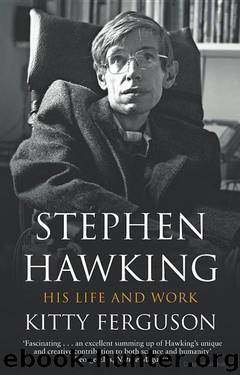Stephen Hawking, His Life and Work by Kitty Ferguson

Author:Kitty Ferguson [Ferguson, Kitty]
Language: eng
Format: epub
Tags: Biography / memoirs / journals
Publisher: Bantam/Transworld Digital/Random House [ebook]
Published: 1991-12-30T16:00:00+00:00
14
‘Between film roles I enjoy solving physics problems’
ANDREI LINDE, WORKING with alex vilenkin in the late 1980s and early 1990s, discovered that an inflationary universe has an amazing potential: in chaotic inflation theory, it can ‘self-reproduce’. The result is an enormous fractal arrangement of universes sprouting one out of another. Hawking’s ‘baby universe’ idea also proposed a multitude of other universes. Our own huge universe was suddenly looking small compared with a possible ‘multiverse’.
Inflation Goes ‘Eternal’
Imagine again one of those regions in the early universe that is inflating rapidly, while some of its neighbouring regions are not. Within that inflating region, Linde and Vilenkin thought, there would be sub-regions that would expand more rapidly than their parent region, while other sub-regions would not. Nor is that the end of the story. Sub-regions would beget sub-sub-regions, and so on and so forth. In other words each microscopic region that inflated would in turn be made up of microscopic sub-regions, some of which would inflate and be in turn made up of microscopic sub-sub-regions, and so on and so forth – an eternal inflationary universe scheme. ‘Eternal inflation’ would be a never-ending process of self-reproduction of the universe. As Linde described it, ‘the universe is a huge, growing fractal. It consists of many inflating balls that produce new balls, which in turn produce more balls, ad infinitum.’1 The universe we know and can observe is just one of these regions, or sub-regions, or sub-sub-regions. Cartoons portrayed Linde as a carnival balloon seller.
Are there ‘parallel universes’ like ours? Not necessarily, though other universes something like ours can’t be ruled out. Even though the total picture including what is beyond ‘our universe’ may be irregular and hugely complicated, in our universe the situation is smooth and relatively simple. Inflation in other regions or sub-regions might also have produced large smooth universes. The whole thing may, in fact, become divided into infinitely many exponentially large regions. However, when energy levels in those other large regions decrease to levels similar to those in our universe today, they will each have different laws of physics. Eternal inflation will produce an infinite variety of universes. In John Barrow’s words, ‘we find ourselves faced with the likelihood that … we inhabit a single, simple patch of space and time in an elaborate cosmic quilt … of huge diversity and historical complexity, most of which is totally inaccessible to us.’2 And we don’t find our patch as it is because it is the most likely kind of universe. It is not.
Barrow used the words ‘historical complexity’ advisedly, for if the whole picture is as eternal inflation describes, there is no reason to think that our own universe exists at or near the beginning of the eternal process. It might have originated as a sub-region of a sub-region of a sub-region – who knows how far we are down the line? In this model, our own universe has a beginning, but the big picture, the enormous fractal arrangement, perhaps need not have either a beginning or an end.
Download
This site does not store any files on its server. We only index and link to content provided by other sites. Please contact the content providers to delete copyright contents if any and email us, we'll remove relevant links or contents immediately.
Hit Refresh by Satya Nadella(9038)
When Breath Becomes Air by Paul Kalanithi(8328)
The Girl Without a Voice by Casey Watson(7821)
A Court of Wings and Ruin by Sarah J. Maas(7651)
Do No Harm Stories of Life, Death and Brain Surgery by Henry Marsh(6890)
Shoe Dog by Phil Knight(5141)
Hunger by Roxane Gay(4869)
The Rules Do Not Apply by Ariel Levy(4861)
A Higher Loyalty: Truth, Lies, and Leadership by James Comey(4843)
Tuesdays with Morrie by Mitch Albom(4690)
Everything Happens for a Reason by Kate Bowler(4678)
The Immortal Life of Henrietta Lacks by Rebecca Skloot(4525)
Millionaire: The Philanderer, Gambler, and Duelist Who Invented Modern Finance by Janet Gleeson(4375)
How to Change Your Mind by Michael Pollan(4292)
All Creatures Great and Small by James Herriot(4232)
The Money Culture by Michael Lewis(4076)
Man and His Symbols by Carl Gustav Jung(4067)
Elon Musk by Ashlee Vance(4028)
Tokyo Vice: An American Reporter on the Police Beat in Japan by Jake Adelstein(3936)
